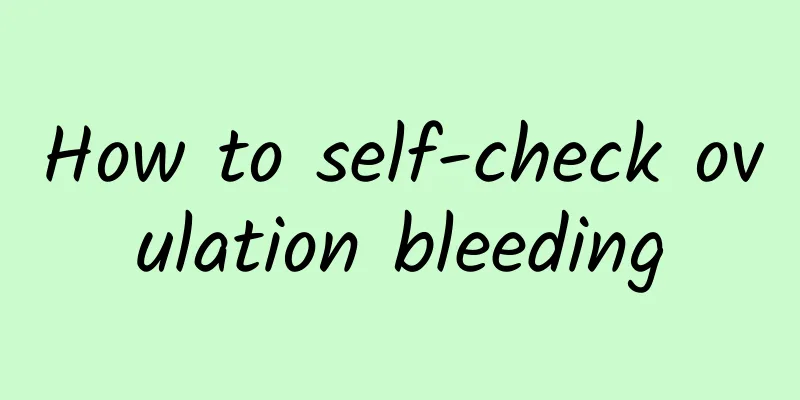How to self-check ovulation bleeding

|
Many people who are preparing for pregnancy know how to calculate the pregnancy period, but sometimes they find that they still have their period even though they are clearly in the ovulation period. Is this their period or something else? Today, I will tell you in detail how to self-check for ovulation bleeding. How to tell if it is menstrual bleeding or ovulation bleeding? First of all, we need to understand what ovulation bleeding is. In the middle of the menstrual cycle, that is, the ovulation period, due to a temporary drop in estrogen levels, the endometrium loses hormonal support and part of the endometrium falls off, causing regular vaginal bleeding, which is called ovulation bleeding. Traditional Chinese medicine calls it "intermenstrual bleeding". However, many women are not so keen on noticing bleeding during or even before and after menstruation. In fact, women usually ovulate about 14 days before the next menstrual period. To be on the safe side, we call the 5 days before and 4 days after ovulation, together with the ovulation day, a total of 10 days, the ovulation period. The rest of the time except the menstrual period is called the safe period. The duration of visible vaginal bleeding can be several hours, or 3 to 5 days, but rarely more than 7 days. In severe cases, it may continue until the next menstrual period. Some people bleed in very little amount, which stops with a few drops, or there is blood in the vagina. Generally, it rarely reaches the amount of menstruation. Bleeding may be accompanied by bloating and discomfort in the lower abdomen on one side, or dull pain or obvious pain, and even involve the waist and inner thigh. Symptoms may occur continuously every month or once every other month. Some people experience it for several months a year, and some people only experience this phenomenon once in their lifetime. Why does ovulation bleeding occur? In fact, every woman who is preparing for pregnancy may experience ovulation bleeding. Generally speaking, the amount of bleeding is very small and cannot be observed with the naked eye. However, some people will have obvious bleeding symptoms, and the severity cannot be generalized. Possible causes are as follows: 1. Excessive fluctuations in hormone levels. After ovulation, estrogen levels drop rapidly, causing the endometrium, which is proliferating under the influence of estrogen, to lose support and cause a little bleeding. 2. Chronic inflammation of the endometrium. This causes the endometrium to become congested during ovulation, or when ovulation occurs, blood vessels on the surface of the ovary rupture, causing more bleeding than normal and flowing back into the uterine cavity with the peristalsis of the fallopian tubes, and then discharged from the body through the vagina. |
<<: What are the dangers of endometriosis?
>>: Women should be alert to the dangers of candidal vaginitis
Recommend
Can I eat strawberries after a miscarriage?
There are many things to pay attention to in wome...
A brief analysis of the postoperative care precautions for ectopic pregnancy surgery
For patients who choose ectopic pregnancy surgery...
What is the TCM differentiation of uterine fibroids? What is the TCM name for uterine fibroids?
What is the TCM differentiation of uterine fibroi...
What is the differential diagnosis of congenital absence of vagina?
In our lives, many people will have congenital ab...
What are the symptoms of irregular menstruation
What are the symptoms of irregular menstruation? ...
Girls love sports! 3 tips to avoid iron legs
Sports awareness is on the rise. Taking advantage...
Follow Demi Moore's raw food diet to lose weight, but beware of rotten teeth
Hollywood's "ageless hot mom" Demi ...
How to take the medicine for medical abortion? See what the doctor says
Medical abortion is also a common method of abort...
What foods are good for the body when you have Bartholin's glanditis?
Bartholinitis is a disease caused by bacterial in...
Symptoms of a large ovarian cyst can cause compression symptoms
Since the symptoms of early ovarian cysts are not...
Experts explain the symptoms of pelvic inflammatory disease in detail for you
Pelvic inflammatory disease is the most common gy...
Experts introduce health care methods for adnexitis
Have you ever heard of adnexitis? How much do you...
Song Joong-ki’s fitness coach teaches you: Stop pursuing thinness, micro muscle lines are popular!
The male god Song Joong-ki has an amazing physiqu...
What are the effective care measures for pelvic inflammatory disease?
How to take good care of pelvic inflammatory dise...
Is it normal to have menopause again after one and a half years? Causes and solutions
Recently, many women have reported that they sudd...









